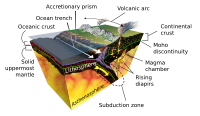
Photo from wikipedia
We present microbeam major- and trace-element data from 14 monzodiorites collected from the Malaspina Pluton (Fiordland, New Zealand) with the goal of evaluating processes involved in the production of andesites… Click to show full abstract
We present microbeam major- and trace-element data from 14 monzodiorites collected from the Malaspina Pluton (Fiordland, New Zealand) with the goal of evaluating processes involved in the production of andesites in lower-arc crust. We focus on relict igneous assemblages consisting of plagioclase and amphibole with lesser amounts of clinopyroxene, orthopyroxene, biotite and quartz. These relict igneous assemblages are heterogeneously preserved in the lower crust within sheeted intrusions that display hypersolidus fabrics defined by alignment of unstrained plagioclase and amphibole. Trace-element data from relict igneous amphiboles in these rocks reveal two distinct groups: one relatively enriched in high field strength element concentrations and one relatively depleted. The enriched amphibole group has Zr values ranging from ∼25–110 ppm, Nb values ∼5–32 ppm, and Th values up to 2.4 ppm. The depleted group, in contrast, shows Zr values <35 ppm, Nb values <0.25 ppm, and Th is generally below the level of detection. Amphibole crystallization temperatures calculated from major elements range from ∼960 to 830 ºC for all samples in the pluton; however, we do not observe significant differences in the range of crystallization temperatures between enriched (∼960–840 ºC) and depleted groups (∼940–830 ºC). Bulk-rock Sr and Nd isotopes are also remarkably homogeneous and show no apparent difference between enriched (εNdi= 0.1 to -0.1; 87Sr/86Sri =0.70420–0.70413) and depleted groups (εNdi=0.3 to -0.4; 87Sr/86Sri=0.70424–0.70411). Calculated amphibole-equilibrium melt compositions using chemometric equations indicate that melts were highly fractionated (molar Mg#<50), andesitic to dacitic in composition, and were much more evolved than bulk lower-continental crust or primitive basalts and andesites predicted to have formed from hydrous melting of mantle-wedge peridotite beneath an arc. We suggest that melts originated from a common, isotopically homogeneous source beneath the Malaspina Pluton, and differences between enriched and depleted trace-element groups reflect varying contributions from subducted sediment-derived melt and sediment-derived fluid, respectively. Our data demonstrate that andesites and dacites were the dominant melts that intruded the lower crust, and their compositions mirror middle and upper bulk-continental crust estimates. Continental crust-like geochemical signatures were acquired in the source region from interaction between hydrous mantle-wedge melts and recycled subducted sediment rather than assimilation and/or remelting of pre-existing lower-continental crust.
Journal Title: Journal of Petrology
Year Published: 2021
Link to full text (if available)
Share on Social Media: Sign Up to like & get
recommendations!